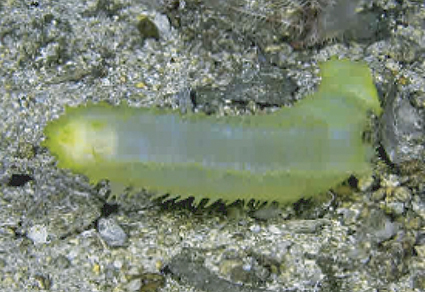Abstract
A new dendrochirotid sea cucumber, Satsumaocnus kaiyomarui gen. nov., sp. nov. from deep water of southern Japan is herein described. The new species displays the following unique characters : a cylindrical, soft body; mouth surrounded by five oral valves; 10 equal, dendritic tentacles arranged in a single circle, each composed of two tufts; a low, stout, compact, calcareous ring without posterior prolongations; body wall ossicles comprising an external layer of small, x-framed hourglass-shaped cups originally described as “double-faced x-framed cup ossicles” in a previous study reported by Yamana et al. (2019), and an inner layer of scarce dendriform/branched rods, sometimes taking the shape of delicate plate-like deposits. Although the general (external and internal) morphological characters of the new species correspond well with the characters of species within the cucumariid subfamily Colochirinae Panning, 1949, our material lacks any buttons or elaborate plate-like ossicles which characterize all extant genera within this subfamily. We, therefore, describe our material as a new species S. kaiyomarui sp. nov. within the new genus Satsumaocnus. The predominant body wall deposits of the new species strongly resemble the hourglass type ossicles of some species of the psolid genus Lissothuria (Verrill, 1867), but differ in their possession of a supporting x-shaped frame. In addition, it is noteworthy that these hourglass deposits also resemble the table ossicles of some holothuriids and stichopodids, when viewed from the side, especially the small tables of some Labidodemas and/or Stichopus species, while the dendriform rods resemble those of Thelenota.
References
Augustin, E. (1908) Über japanische Seewalzen. In: Doflein, F. (Ed.), Beiträge zur Naturgeschichte Ostasiens, Abhandlung der Mathematish-Physikalischen Klasse der Königlich Bayerischen Akademie der Wissenschaften 2. Supplement Vol. 1. Königlich Bayerischen Akademie der Wissenschaften, Munich, pp. 1–44.
Burmeister, H. (1837) Handbuch der Naturgeschichte. Zum Gebrauch bei Vorlesungen. Zweite Abtheilung. Zoologie. T.C.F. Enslin, Berlin, xii + pp. 858. [Zoology 369–858, https://biodiversitylibrary.org/page/46857365] https://doi.org/10.5962/bhl.title.100177
Forbes, E. (1841) A history of British Starfishes and other animals of the class Echinodermata. John Van Voorst, London, 267 pp. https://doi.org/10.5962/bhl.title.2129
Gilliland, P.M. (1993) The skeletal morphology systematics and evolutionary history of holothurians. Special in Palaeontology. No. 47. The Palaeontological Association, London, 147 pp.
Imaoka, T. (1990) Holothuroidea. In: Imaoka, T., Irimura, S., Okutani, T., Oguro, C. & Kanazawa, K. Echinoderms from the Continental Shelf and Slope around Japan. Vol. I. The Intensive Research of Unexploited Fishery Resources on Continental Slopes. Japan Fisheries Resource Conservation Association, Tokyo, pp. 1–159.
Imaoka, T. (1991) Holothuroidea. In: Imaoka, T., Irimura, S., Okutani, T., Oguro, C. & Kanazawa, K., Echinoderms from the Continental Shelf and Slope around Japan. Vol. II. The Intensive Research of Unexploited Fishery Resources on Continental Slopes. Japan Fisheries Resource Conservation Association, Tokyo, pp. 1–204.
Imaoka, T. (1995) Holothuroidea. In: Nishimura, S. (Ed.) Guide to Seashore Animals of Japan with Color Pictures and Keys. Vol. II. Hoikusha, Osaka, pp. 553–572. [in Japanese]
Ludwig, H. [1889–1892 (1889)] Die Seewalzen. In: Bronn, H.G. (Ed.), Klassen und Ordnungen des TheirReichs. I. Buch. C. F. Winter, Leipzig, pp. 1–460, pls. I–XVII. [pp. 1–176, figs. 1–16, pls. I–VIII (1889), pp. 177–240, pls. IX–XII (1890), pp. 241–376, figs. 17–24, pls. XIII–XVII (1891), pp. 377–460, fig. 25 (1892)]
Ludwig, H. (1894) The Holothurioidea. In: Reports on an exploration off the west coasts of Mexico, Central and South America, and off the Galapagos Islands, in charge of Alexander Agassiz, by the U. S. Fish Commission Steamer "Albatross," during 1891, Lieut. Commander Z. L. Tanner, U. S. N., commanding. XII. Memoirs of the Museum of Comparative Zoölogy at Harvard College, 1 (3), 1–183, 19 pls. [https://www.biodiversitylibrary.org/item/25502#page/7/mode/1up]
Marenzeller, E. (1882) Neue Holothurien von Japan and China. Verhandlungen der Zoologisch-Botanischen Gesellschaft in Wien, 31, 121–140. [dated 1881] https://doi.org/10.5962/bhl.part.20315
Miller, A.K., Kerr, A.M., Paulay,G., Reich, M., Wilson, N.G., Carvajal, J.I. & Rouse, G.W. (2017) Molecular Phylogeny of Extant Holothuroidea (Echinodermata), Molecular Phylogenetics and Evolution, 111, 110–131. https://doi.org/10.1016/j.ympev.2017.02.014
Mitsukuri, K. (1912) Studies on Actinopodous Holothurioidea. The Journal of the College of Science, Imperial University of Tokyo, XXIX (Art. 2), 1–284. https://doi.org/10.5962/bhl.title.37880
Mortensen, T. (1925) Holothurioidea. In: Papers from Dr. Th. mortensen’s Pacific Expedition 1914–16. XXIX. Echinoderms of New Zealand and the Aukland-Campbell Islands. IV. Videnskabelige Meddelelser fra Dansk naturhistorisk Forening i Kjobenhavn Foren, 79, pp. 322–386
Ohshima, H. (1915) Report on the holothurians collected by the United States Fisheries Steamer “ALBATROSS” in the Northwestern Pacific during the summer of 1906. Proceedings of the United States National Museum, 48, 213–291. https://doi.org/10.5479/si.00963801.48-2073.213
O’Loughlin, P.M., Barmos, S. & Vandenspiegel, D. (2011) The paracaudinid sea cucumbers of Australia and New Zealand (Echinodermata: Holothuroidea: Molpadida: Caudinidae). Memoirs of the Victoria Museum, 68, 37–65. https://doi.org/10.24199/j.mmv.2011.68.03
Panning, A. (1949) Versuch einer Neuordnung der Familie Cucumariidae (Holothurioidea, Dendrochirota). Zoologische Jahrbücher, Abteilung für Systematik, Ökologie und Geographie der Thiere, 78, 404–470.
Smirnov, A.V. (2012) System of Class Holothuroidea. Palentological Journal, 46 (8), 793–852. https://doi.org/10.1134/S0031030112080126
Thandar, A.S. & Samyn, Y. (2004) Taxonomy of the monotypic genus Koehleria Cherbonnier, 1988 (Echinodermata: Holothuroidea: Cucumariidae). Zootaxa, 652 (1), 1–11. https://doi.org/10.11646/zootaxa.652.1.1
Thandar, A.S. (2017) Two new subfamilies, three new species and a new subspecies of dendrochirotid sea cucumbers (Echinodermata: Holothuroidea). Zootaxa, 4365 (4), 410–420. https://doi.org/10.11646/zootaxa.4365.4.2
Théel, H. (1886) Report on the Holothurioidea dredged by H.M.S. Challenger during the years 1873–76. Part II. Report of the Scientific Results of the Exploring Voyage of H.M.S. Challenger during the Years 1873–76, Zoology, 39, 1–290.
Verrill, A.E. (1872) Brief contributions to zoology from the museum of Yale College No. XXII. On Radiata from the coast of North Carolina. Transactions Connecticut Academy Arts & Sciences, 3, 432–438. https://doi.org/10.2475/ajs.s3-3.18.432
Yamana, Y. & Kohtsuka, H. (2018) Dendrochirotid holothurians (Echinodermata: Holothuroidea: Dendrochirotida) including four new species, from off Misaki, Japan. Zootaxa, 4455 (3), 429–453. https://doi.org/10.11646/zootaxa.4455.3.2
Yamana, Y., Hayashibara, T., Yamamoto, M., & Setiamarga, D.H.E. (2019) First observation of the "double-faced x-framed cup ossicle" extracted from a deep sea holothurian in Japan. Zoosymposia, 15, 203–211. https://doi.org/10.11646/zoosymposia.15.1.21
Yamana, Y., Nakaguchi, K., Yamaguchi, S., Katoh, M., Ogawa, A. & Ohtsuka, S. (2021) Four new dendrochirotid holothurians collected from the Seto Inland Sea and the western part of the Sea of Japan, western Japan. Zootaxa, 5023 (1), 1–43. https://doi.org/10.11646/zootaxa.5023.1.1


